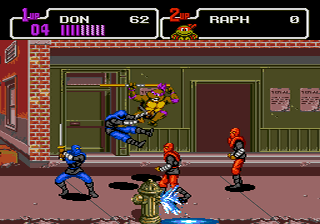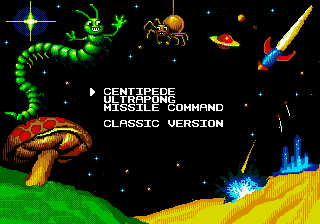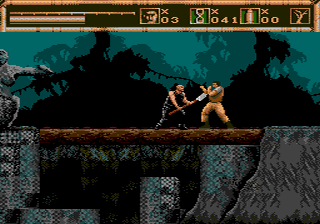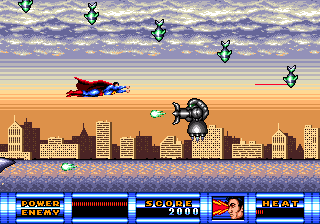Put down that turkey leg! You can’t eat your Thanksgiving dinner until you’ve given thanks for some of the truly good things in life: Genesis games! This year, forget football and gather the family around the Genesis instead. Or, why not have the best of both worlds and play some Genesis football games! Seriously, there’s no better time to introduce your family to some great retro gaming.
TMNT Hyperstone Heist By Ken Horowitz
 I’ve never been able to really enjoy Thanksgiving as a gaming holiday, what with the rush of family who don’t like games and the inevitable pants-breaking feast that culminates the day. Usually, I don’t get to game until most of my relatives have left, but this year I plan to make an exception! Since the little ones are really into Ninja Turtles again, I’m breaking out my copy of Hyperstone Heist and letting them see some old school turtle action. It’s a shame that the game is only two-player, but hell, they can take turns! That’s how we did it back in my day, and it’ll have to be good enough for them! T
I’ve never been able to really enjoy Thanksgiving as a gaming holiday, what with the rush of family who don’t like games and the inevitable pants-breaking feast that culminates the day. Usually, I don’t get to game until most of my relatives have left, but this year I plan to make an exception! Since the little ones are really into Ninja Turtles again, I’m breaking out my copy of Hyperstone Heist and letting them see some old school turtle action. It’s a shame that the game is only two-player, but hell, they can take turns! That’s how we did it back in my day, and it’ll have to be good enough for them! T
The most interesting thing about this whole scenario? I don’t think there’s a TMNT game today that’s as fun as the 16-bit ones are. I guess it’s true what they say: the more things change, the more awesome the Sega Genesis becomes…
NHL ’94 By Sebastian Sponsel
Anniversaries can be a funny thing. This year, EA Sports decided to launch their newest edition in their NHL-franchise with NHL’14. And to commemorate 20 years of the classic NHL ’94, instead of overhauling the engine or do some major gameplay tweaks, the biggest update to the game was a NHL ’94 anniversary mode. Never mind the fact that the franchise actually premiered two years earlier with NHL Hockey on the Genesis, or that NHL ’94 wasn’t even the first cross-platform title (NHLPA Hockey ’93 was also ported to the SNES). But then again, NHL ’94 WAS a breakthrough title that greatly improved gameplay and set the standard for 16-bit hockey games in general.
 The NHL ’94 anniversary mode is just a bare bones arcade-style game though: No rules, minimalist control scheme, fixed period length (3×5 minutes). And I admit, playing that was a lot of fun. Personally, I even preferred it to the increasingly complicated “realistic” controls of the main game. Nevertheless, I felt compelled to pop in NHL ’94 again in order to compare the two. Mainly because I knew that NHL ’94 was actually way more than the simple modern day allusion suggested: penalty options, varying game length, line changes… all that is missing from the anniversary mode. If you played NHL ’94 with the shortest period length and all the optional rules switched off though, then there’s a remarkable similarity. Also, I was kind of disappointed: When EA had announced that there would be an anniversary mode, I half expected to hear chip tune sounds and sprite graphics. Alas, the engine is the same as in NHL ’14, just tweaked to somewhat resemble the NHL ’94 camera angle.
The NHL ’94 anniversary mode is just a bare bones arcade-style game though: No rules, minimalist control scheme, fixed period length (3×5 minutes). And I admit, playing that was a lot of fun. Personally, I even preferred it to the increasingly complicated “realistic” controls of the main game. Nevertheless, I felt compelled to pop in NHL ’94 again in order to compare the two. Mainly because I knew that NHL ’94 was actually way more than the simple modern day allusion suggested: penalty options, varying game length, line changes… all that is missing from the anniversary mode. If you played NHL ’94 with the shortest period length and all the optional rules switched off though, then there’s a remarkable similarity. Also, I was kind of disappointed: When EA had announced that there would be an anniversary mode, I half expected to hear chip tune sounds and sprite graphics. Alas, the engine is the same as in NHL ’14, just tweaked to somewhat resemble the NHL ’94 camera angle.
However, with all being said and done, I hate to admit it, but I actually preferred playing the anniversary mode. Back in 1994 I was amazed how fast and smooth the game played, but now, 20 years later, it actually seemed very rough and jerky by comparison. The fact that I had to play it on my PAL console probably factors in heavily in this account. Bottom line: anniversary mode, great idea, love playing it, probably the best thing about NHL ’14! Still don’t understand why they included it two years late, though.
Arcade Classics By The Coop
With a title like Arcade Classics, there were endless possibilities. Many arcade games were released before this collection came out, so the pool to choose from was enormous. Atari, SEGA, Midway… those three companies alone have a ridiculous number of classic titles that the Genesis could do with ease. The expectation bar was set high… only to slip of and land on all of our heads.
This game is filled with ports of three older arcade games; Centipede, Missile Command, and Pong… yes, Pong. All three are admittedly classics of their time, and they all have simple graphics, sounds, and concepts that the Genesis could do is its sleep. But somewhere along the way, the decision was made to give this project to a small group of straight jacketed inmates at a psycho ward, who weren’t allowed to use their hands for fear of them hurting someone. As such, it was programmed and created using only their feet and occasional forehead slams to a keyboard. At least, that’s the only way I can figure why it turned out this badly.
 Arcade Classics botches so many aspects of these games, that it’s embarrassing. It’s to the point of leaving me wondering if the people behind Arcade Classics played all the games they were recreating for more than one level. As a few examples, in Missile Command, the smart bombs just go right into explosions without skirting around them, and some of the missiles hit parts of the ground between the cities and defense mounds (harming nothing). The missiles leave dotted trails and are tougher to see, the explosions are smaller, stutter visually, and don’t even do the cool dissolving effect from the arcade version, and you only have the central defense mound to shoot from (the controller has three buttons… why weren’t they all used so we could fire from the left, middle and right?!). In Pong, they made a CPU paddle that virtually never misses, and got the paddle behavior wrong in how the ball reacts according to where it hits the paddle. In Centipede, your little character controls very sluggishly, and the game is absolutely littered with slowdown. I’m not joking. Slowdown… in Centipede. I mean come on… the Atari 400/800 handled these games better. And as if that weren’t enough, all three games had their graphics tampered with. They weren’t redrawn to be more detailed or anything, it’s this weird half and half look that simply makes it look like they just messed up with how the arcade graphics were drawn. And yep, the sound is just as off, as these games really don’t sound like the arcade originals.
Arcade Classics botches so many aspects of these games, that it’s embarrassing. It’s to the point of leaving me wondering if the people behind Arcade Classics played all the games they were recreating for more than one level. As a few examples, in Missile Command, the smart bombs just go right into explosions without skirting around them, and some of the missiles hit parts of the ground between the cities and defense mounds (harming nothing). The missiles leave dotted trails and are tougher to see, the explosions are smaller, stutter visually, and don’t even do the cool dissolving effect from the arcade version, and you only have the central defense mound to shoot from (the controller has three buttons… why weren’t they all used so we could fire from the left, middle and right?!). In Pong, they made a CPU paddle that virtually never misses, and got the paddle behavior wrong in how the ball reacts according to where it hits the paddle. In Centipede, your little character controls very sluggishly, and the game is absolutely littered with slowdown. I’m not joking. Slowdown… in Centipede. I mean come on… the Atari 400/800 handled these games better. And as if that weren’t enough, all three games had their graphics tampered with. They weren’t redrawn to be more detailed or anything, it’s this weird half and half look that simply makes it look like they just messed up with how the arcade graphics were drawn. And yep, the sound is just as off, as these games really don’t sound like the arcade originals.
Admittedly, Missile Command is the worst offender, with Centipede just being much slower and off visually, and Pong being cheap and not working quite right. But these should have been spot on arcade ports, with enhanced versions that gave us nice, updated 16-bit graphics. Instead, it was a half-assed project that obviously even the people working on it didn’t care about. And yet it still got released to a then unsuspecting consumer base. People bought Arcade Classics expecting some old school arcade goodness, but they instead wound up with a terrible experience that was like a proverbial slap to the face of the original arcade games, and the people who made them.
No Escape By Goldenband
Over the past year or so, two former employees of the 3DO Company have been putting together a series of Let’s Play videos on Youtube, in which these veteran programmers reminisce about their experiences in the industry while playing 3DO games like Escape from Monster Manor and Battlesport. For those interested in early 32-bit gaming history, the commentary on these videos is full of technical information and “behind the scenes” stories — and even if that era isn’t your thing, they make many worthwhile, trenchant observations about the gaming industry and its follies.
So why am I waxing lyrical about 3DO videos on a Sega site? Well, in a recent video, they looked at PO’ed, a 3DO FPS that seems like little more than a sophomoric Doom clone at first, but eventually picks up with some extremely impressive jetpack stages…stages that few people ever saw, however, since most players soon lost interest in killing evil butt monsters with a frying pan. (No, I’m not joking.)
Apropos this, one of the ex-3DO guys noted that far too many good games have unwittingly sabotaged themselves by starting out with a weak or boring level, and saving their best stuff for later in the game. I think we can all think of a game like that — one we stuck with and ultimately enjoyed, but almost gave up on near the start because the first stages were so uninspiring. There are so many examples that the idea deserves to be an axiom of the gaming world, or at least should have its own dedicated graveyard. And seldom have I seen a game that better exemplifies this than Psygnosis’ No Escape.

Like most players who fire up this licensed movie tie-in, my reaction to the game’s opening levels was utter revulsion. “You never get a second chance to make a first impression,” or so the old shampoo commercial told us, and No Escape‘s first impression is abysmal indeed: drab, poorly dithered graphics; flaky controls that resemble Out of this World or Flashback gone very wrong; spike-filled pits that seem impossible to vault over; and an unending stream of enemies whose relentless onslaught is both demoralizing and infuriating. Now throw in a complete joke of a mini boss, pile on another level like the first one, and if you haven’t hit the POWER button yet you’re a sturdier soul than I was. It all seems like the epitome of licensed-property trash, and a real nadir for Psygnosis.
Yet get past all this, and No Escape turns out to be a pretty decent little title that combines puzzle-solving, combat, platforming, exploration, and a small-scale bartering economy. Once you finish the opening levels and reach the Insiders’ Village, you can select one of five different stages, gather information and trade with the residents, or try to combine the items you’ve collected to make weapons or tools. The puzzles are challenging, the item combinations are fun to discover, and the game offers a healthy supply of continues to keep the frustration factor low.
I’d gotten to roughly this point before, but this month I finally stuck with No Escape. I ended up playing through the whole game twice and, to my surprise, enjoyed it quite a bit. That’s not to say that it’s a masterpiece, because it surely isn’t: even once you learn the controls, they remain quirky at best, and certain gameplay features are obscure or undercooked.
But unlike, say, Blackthorne, a lousy, lazy game whose acclaim mystifies me to this day, there’s actual depth and non-linearity in No Escape. There are multiple ways to win, whole areas that you can skip or explore if you so choose, and at least two different endings. It frequently rewards clever or adventurous players, and your actions have an enduring effect on the game’s landscape.
Would I recommend No Escape? Well, not to most people, I think: only very tolerant gamers will get past the beginning, and though the game is pretty forgiving after that, it’s still going to be an acquired taste at best. And if you’re the kind of person who’ll jump at the slightest pretext to heap scorn upon a game and trot out your impression of the Angry Video Game Nerd, do everyone a favor and definitely avoid this one.
But be that as it may, the point is that No Escape doesn’t deserve its reputation as one of the worst Genesis games ever made: it just has one of the worst beginnings. That was more than enough to scuttle a game even in 1994, and in today’s instant-gratification, if-I-don’t-understand-something-it-must-be-stupid culture, it’s the kiss of death. That’s a shame, since despite its flaws there was some real TLC put into No Escape — but few will ever play it for long enough to find that out.
Superman By David Dyne
Back in the day I never knew there was a second Superman game by Sunsoft on the Genesis apart from the Death and Return of Superman. It was one of those titles that managed to slip under the radar which wasn’t hard considering how limited our information sources for video games were back then. Being a huge fan of Sunsoft’s Batman, I picked up a copy of Superman about two years ago and decided to give it a whirl for this month’s Reader Roundtable.
Superman’s best quality is its excellent soundtrack, with two tracks in particular; the pulse pounding boss battle theme and the final stage onboard Brainiac’s ship. The rest of the game is marred by unbalanced gameplay that will easily frustrate the most placid of players. It’s also annoying that the U.S. version didn’t receive the same level of polish that the PAL Mega Drive version did with improved collision detection and an options menu for difficulty selection and a sound test for music nuts like me that enjoy slapping in a game to play some music while I’m doing something else. Who needs an iPod when you have a Sega Genesis acting as a jukebox?
 I can see why plenty of folks passed on this game or just gave up on it during the brutal third level subway or even the first level for that matter. Superman is one of those titles that have to stick with in order to make any progress. It took me about two weeks to play through this one to learn the enemy attack patterns and the appropriate counter-attack to avoid taking damage as health power ups range from few and far between to none at all in stages where enemy placement is all about trying to bleed as much of your health as possible before a boss battle. Level designs are varied with side-scrolling ground based robot smashing action and some flying stages where you’ll blast everything with heat vision beams as you rescue children and knock the stuffing out of villains from Superman’s rogues gallery like the Prankster and Metallo before having to rescue the capture-prone Lois Lane from Brainiac’s clutches. Get yourself a turbo controller for the flight stages so you can save your attack button from being mashed to pieces.
I can see why plenty of folks passed on this game or just gave up on it during the brutal third level subway or even the first level for that matter. Superman is one of those titles that have to stick with in order to make any progress. It took me about two weeks to play through this one to learn the enemy attack patterns and the appropriate counter-attack to avoid taking damage as health power ups range from few and far between to none at all in stages where enemy placement is all about trying to bleed as much of your health as possible before a boss battle. Level designs are varied with side-scrolling ground based robot smashing action and some flying stages where you’ll blast everything with heat vision beams as you rescue children and knock the stuffing out of villains from Superman’s rogues gallery like the Prankster and Metallo before having to rescue the capture-prone Lois Lane from Brainiac’s clutches. Get yourself a turbo controller for the flight stages so you can save your attack button from being mashed to pieces.
Is this game fun? Sunsoft clearly didn’t give Superman the same level of attention to detail that they did with Batman. Had they done so, we could have ended up with a much better game that didn’t fall by the wayside over time. Overall I thought it was pretty good but not great by any means. If you’re one of those players who enjoys a significant challenge then by all means give this one a shot.

Ha! I tried out Arcade Classics back in the day on the Sega Channel. It was so horrible I didn’t believe it was a real game until I saw it reviewed in EGM. Love TMNT though, still one of my favorites!